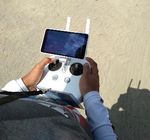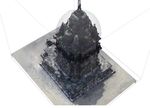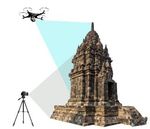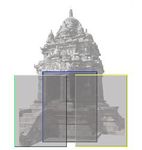ARCHITECTURAL PHOTOGRAMMETRY: A LOW-COST IMAGE ACQUISITION METHOD IN DOCUMENTING BUILT ENVIRONMENT - International Journal of GEOMATE
←
→
Page content transcription
If your browser does not render page correctly, please read the page content below
International Journal of GEOMATE, May., 2021, Vol.20, Issue 81, pp.100-105
ISSN: 2186-2982 (P), 2186-2990 (O), Japan, DOI: https://doi.org/10.21660/2021.81.6263
Geotechnique, Construction Materials and Environment
ARCHITECTURAL PHOTOGRAMMETRY: A LOW-COST IMAGE
ACQUISITION METHOD IN DOCUMENTING BUILT
ENVIRONMENT
Yohannes Firzal*
Faculty of Engineering, Universitas Riau, Indonesia
* Corresponding Author, Received: 15 Jun. 2020, Revised: 01 Feb. 2021, Accepted: 13 Feb. 2021
ABSTRACT: Architectural photogrammetry, as a digital survey method requires photographic images produced
by using a precision camera. This method, particularly the close-range photogrammetry, has been more effectively
used than other techniques such as laser scanning. This paper aims to show that the close-range photogrammetry
is a practical way and low-cost image acquisition in architectural projects. By applying a sequential two-step
process method, capturing images in the field and using photogrammetry software has conducted to generate from
the point cloud to the architectural model. This model shows a high level of accuracy detail from a part of the Sewu
Temple Indonesia, where this research has conducted. Thus, this research concludes that using architectural
photogrammetry is to obtain accuracy detail of architecture object in complex nature and as a low cost and effective
methods.
Keywords: Architectural Photogrammetry, Photographic Image, Acquisition, Software
1. INTRODUCTION design and reconstruct the built form. Therefore,
photogrammetry becomes an effective tool and a low-
Photogrammetry is known as a digital image cost method [15]. Photogrammetry is not to change
processing method in orthoimages and image an architect's role, but a means in helping to present
mosaics. Photogrammetry has mostly used in the field the architecture [16].
of archaeology [1]. However, today's
photogrammetry has widely recognized as an 2. THEORETICAL BACKGROUND
alternative low-cost solution in image processing [2]
compared to the laser scanning method [3]. Photogrammetry has developed in various ways
Photogrammetry has applied in various disciplines and technologies. Architectural photogrammetry can
[4] such as geoscience [5], structural engineering [6], generate a 3D model by a combination of methods,
zooarchaeology [7], heritage documentation [8] [9], namely laser-scanning, aerial photogrammetry, close-
archaeology [10], buildings inspection [11] and range photogrammetry, computer modelling,
architectural representation [12]. traditional lines drawings, and physical model
There are groups of kinds in photogrammetry. building [17]. In particular, in the image acquisition
One of them is known as close-range process, architectural photogrammetry can also
photogrammetry (CRP). The CRP has adopted from combine different cameras or lenses by taking at least
the aerial photogrammetry. This adaptation has aimed two rays of satisfactory intersection angle of images
to fit with a specific field such as architecture [13]. (Fig. 1) [18] with various devices such as DSLR and
The adoption of this CRP gives a new possibility in the Unmanned Aerial Vehicle (UAV) [19].
the digital image processing by using less equipment. Using photogrammetry will push forward and
At least, CRP requires a camera, personal computer expand architectural methods in the documenting-
and scale bar to obtain a 3D image [14]. The built environment. As a digital form of technology,
application of CRP in architecture is a non-intrusive the photogrammetry offers more flexibility to manage
technique in documenting and producing a 3D model. images and essential measurement for architectural
Conventionally, the documenting and 3D image have analysis and documentation methodologies [20]. The
collected from 2D technics such as sketch and photogrammetry can generate a geometric of a
mechanical drawing following up to vector and precise model and architectural representation in
massing software. limited time [21] and makes the process of survey
In contrast, the photogrammetry sequentially short, free of danger and mistakes [22] [23]. The
generates serial images to points cloud that can photogrammetry also opens to develop and combine
conduct in fast and accurate detail of the 3D object. with other BIM software [24]. Therefore, the
As digitally formed, a virtual model of CRP architectural photogrammetry is not going to replace
represents existing built forms and possibly used to conventional method in image acquisition. Instead, it
100International Journal of GEOMATE, May., 2021, Vol.20, Issue 81, pp.100-105
helps architect in their works and the cheapest, devices; DSLR camera and drone (Fig. 2).
practical and suitable technique for the 3D
digitization and documentation.
Fig. 1 The configuration of the camera for image
acquisition
3. RESEARCH METHODOLOGY
The method in photogrammetry has organized in Fig. 2 The overlapping of the block images by Using
sequential steps. In this paper, close-range DSLR and Drone
photogrammetry has conducted in a two-step process.
The first step is capturing photographic images from Another fundamental parameter is image
various angles by using a DSLR camera and drone. distortion that is caused by reasons such as operator
This step is called the fieldwork phase applied to position, lenses-used, amount of light, the angel of the
collect quality and geometric information of the device, and assistive devices (Fig. 3). Therefore, in
images such as position, size, contrast, filtering and practical ways, the number of technical images
shape. This first step has much more relied on the skill captured are significant not only to reduce the
of the person who has operated the devices [18]. distortion [27] [28] but also to contribute to
The second step is to arranged the images by generating the density of the points cloud [29].
applying photogrammetry software to generate dense
cloud and texture data. The software is automatically
interpreting the semantic information of the image
[25]. This computational phase is sequentially run in
the software's workflow to obtain 3D images at the
end of the process.
The architectural site of this research was on the
Sewu Temple in Central Java, Indonesia. It has
focused on one of the hundreds of stupas. It has used
a Canon DSLR D-60 with an EF 50 mm f/1.4 USM Fig. 3 Acquiring Overlapped Images Using DSLR
lens with a tripod in acquisition images. The UAV Camera
used was a DJI Phantom 4 quadcopter drone equipped
with a camera 35 mm lens. In the cloud images As using a metric device, DSLR camera with
processes, this research has used an Agisoft metric attributes is an ideal tool to produce technical
Metashape Professional 64-bit software. A images. However, it is necessary to set lenses-used to
comparison of the device has also used Leica ensure consistency of the focal length. Therefore, the
RTC360 3D Laser Scanner with a tripod to produce a metric camera calibration [30] [31] needs to control
similar result. while collecting images. In practical ways, using
prime lenses or fixed lenses can avoid this control.
4. RESULT AND DISCUSSION Slightly different on a drone, as having a non-
metrical camera, it is necessary to use a drone with a
The field operator must understand several high-quality camera to ensure the image quality
technical parameters. The most basic setting is multi- produced [24]. A drone is a useful device to acquire
image restitution of a block of overlapping images fast and accurate images that cannot be captured on
and collinearity equations [26]. The block images certain positions by DSLR camera such as at a high-
must be arranged in between 60% to 80% overlaid on level place, large area, delicate angels [32] [33]. In
each image. This block means that the degree of practical ways, besides numbers and overlapping
overlapping is correlating to effects on detail images, it is also necessary for a drone operator to
obtained. In this research, the overlap is not only have a proper flight plan in avoiding an images
applied on the block images, but also between the overabundance (Fig. 4).
blocks. It means that two-block images are generated
horizontally and vertically in direction using two
101International Journal of GEOMATE, May., 2021, Vol.20, Issue 81, pp.100-105
In every phase, the photogrammetry software shows
the preferences dialogue command before
continuing the processing, giving a chance to correct
or adjust during the process. The last phase in the
photogrammetry software is exporting the result and
making the 3D model available to other software
such as BIM platform [35] [36] [37].
Fig. 4 Using Drone's Camera in Acquiring Image
Mosaics
All images that cameras have acquired then are
generated by photogrammetry software. There are
several alternatives software which can process the
image. The software is available for commercial and
open-source options based on computer skills and
requirements [34].
This generating process is following the workflow.
The workflow starts with aligning images. In this first
phase, the interface software shows a position and Fig. 7 Creating the Ortho-mosaic Images
orientation of images and builds a sparse a point cloud
model. From here, this earliest model displays two From the whole process, this close-range
groups of arranged images on the main windows, and photogrammetry (CRP) shows more advantageous
sources images on the bottom pane (Fig. 5). than conventional methods (Fig. 8). CRP can be
conducted in limited time to obtain a 3D model [22]
[38]. The photogrammetry process can also be
accurately recovered regardless of the size of the
object [39].
Fig. 5 Aligning Images in Photogrammetry Software
The next phases are sequentially building dense
point cloud and building mesh (3D polygonal model)
(Fig. 6).
Fig. 8 The Result of Point Cloud 3D Model
As a comparison of the result, this research has
also used a laser scanner device on the same research
object (Fig. 9 left). The laser scanner can produce a
significant volume of points cloud (Fig. 9 right) and
generates very great detail in fast and precision both
on an object and large area [19]. For this reason, the
laser scanner still the best device in documenting field
data until today. However, as a part of its advantage,
this device's price is still high, and for maintaining
Fig. 6 Generating a Point Cloud Model
and routines, calibration makes laser scanner less
practical and economical. Therefore, it is necessary to
The process has continued to build texture, build
provide a low-cost alternative method and practice
a tiled model, build a digital elevation model using close-range photogrammetry.
(DEM), and build ortho-mosaic (Fig. 7).
102International Journal of GEOMATE, May., 2021, Vol.20, Issue 81, pp.100-105
10.3923/itj.2009.202.207.
[5] Westoby. M. J., Brasington. J., Glasser. N. F.,
Hambrey. M. J., and Reynolds. J. M.,
"Structure-from-Motion photogrammetry: A
low-cost, effective tool for geoscience
applications," Geomorphology, vol. 179, pp.
300–314, Dec. 2012, DOI:
10.1016/j.geomorph.2012.08.021.
Fig. 9 Using Laser Scanner Device (left) and Point [6] Han. J., Hong. K. and Kim. S., "Application
Cloud Model (right) of a Photogrammetric System for Monitoring
Civil Engineering Structures," 2012.
5. CONCLUSION [7] Evin. A., "The use of close-range
photogrammetry in zooarchaeology: Creating
The close-range photogrammetry (CRP) overs accurate 3D models of wolf crania to study
architecture efficiency in the time process and gave dog domestication," J. Archaeol. Sci.
alternative and valuable method in obtaining a Reports, vol. 9, pp. 87–93, Oct. 2016, DOI:
complete exterior of an architectural model. From this 10.1016/j.jasrep.2016.06.028.
paper, a combination of DSLR camera, drone and the [8] Remondino. F., "Heritage recording and 3D
photogrammetry software shows the 3D architectural modelling with photogrammetry and 3D
model produced can be generated from a natural scanning," Remote Sens., vol. 3, no. 6, pp.
setting into a high technical accuracy detail. 1104–1138, Jun. 2011, DOI:
However, due to less familiarity with the software 10.3390/rs3061104.
workflow, the photogrammetry becomes less used in
[9] Morita. M. and Bilmes. G., "Applications of
the practice of obtaining information in architectural low-cost 3D imaging techniques for the
objects. The software also requires mastery of more documentation of heritage objects," Opt.
advanced software to process further architectural Pura y Apl., vol. 51, no. 2, pp. 1–11, 2018,
models that have produced to be compatible with DOI: 10.7149/OPA.51.2.50026.
other fields. [10] Nakano. K. and Chikatsu. H., "Camera-
variant calibration and sensor modelling for
6. REFERENCES practical photogrammetry in archaeological
sites," Remote Sens., vol. 3, no. 3, pp. 554–
[1] Hemmleb. M. and Wiedemann. A., "Digital
569, Mar. 2011, DOI: 10.3390/rs3030554.
Rectification And Generation Of [11] Murtiyoso. A., Remondino. F., Rupnik. E.,
Orthoimages In Architectural Nex. F. and Grussenmeyer. P., "Oblique
Photogrammetry," in IAPRS, 1997, vol. aerial photography tool for building
XXXII, pp. 261–267, [Online]. Available:
inspection and damage assessment," in
https://www.researchgate.net/publication/23
International Archives of the
54891. Photogrammetry, Remote Sensing and
[2] Grussenmeyer. P. and Al Khalil. O., "From Spatial Information Sciences - ISPRS
metric image archives to point cloud
Archives, 2014, vol. 40, no. 1, pp. 309–313,
reconstruction: Case study of the great DOI: 10.5194/isprsarchives-XL-1-309-2014.
mosque of Aleppo in Syria," in International [12] Núñez. M. A., and Pozuelo. F. B., “Evolution
Archives of the Photogrammetry, Remote of the architectural and heritage
Sensing and Spatial Information Sciences - representation,” Landsc. Urban Plan., vol. 91,
ISPRS Archives, Aug. 2017, vol. 42, no. no. 2, pp. 105–112, Jun. 2009, doi:
2W5, pp. 295–301, DOI: 10.5194/isprs- 10.1016/j.landurbplan.2008.12.006.
archives-XLII-2-W5-295-2017. [13] Hanke. K. and Ebrahim. M., "Monument
[3] Barsanti. S. G., Remondino. F. and Visintini. Presentation Using Digital Architectural
D., "3D SURVEYING AND MODELING Photogrammetry," 1997. [Online]. Available:
OF ARCHAEOLOGICAL SITES," in ISPRS https://www.researchgate.net/publication/23
Annals of the Photogrammetry, Remote 6155255.
Sensing and Spatial Information Sciences, [14] Murtiyoso. A. and Suwardhi. D., “Teknik
Volume II-5/W1, 2013 XXIV International Pencocokan Citra dalam Fotogrametri untuk
CIPA Symposium, 2 – 6 September 2013, Dokumentasi Cagar Budaya Indonesia
Strasbourg, France, 2013, pp. 145–150.
Banana Biodiversity and Biogeography Big
[4] Yakar. M., Yilmaz. H. M., Gülec. S. A., and Data View project DBAT-The Damped
Korumaz. M., "Advantage of digital close- Bundle Adjustment Toolbox in Matlab View
range photogrammetry in drawing of project,” in Bunga Rampai Forum Peneliti
muqarnas in architecture," Inf. Technol. J., Muda Indonesia 2017, 2017.
vol. 8, no. 2, pp. 202–207, 2009, DOI:
103International Journal of GEOMATE, May., 2021, Vol.20, Issue 81, pp.100-105
[15] Alby. E., Grussenmeyer. P., Perrin. J. P., DOI: 10.3390/su10072259.
"Integration of Close Range [25] Wiedemann. A., "From Analogue To Digital
Photogrammetric Survey in the Design Close-Range Photogrammetry," 1998.
Process of Architectural Projects, New [Online]. Available:
perspectives to save Cultural Heritage," in https://www.researchgate.net/publication/23
XIXth CIPA International Symposium, Oct 32200.
2003, Antalya, Turkey, 2003, pp. 46–51, [26] Alexandru. A. and Popescu. G., "Introduction
[Online]. Available: https://halshs.archives- in Architectural Photogrammetry," 2016.
ouvertes.fr/halshs-00263999. [27] Karras. G., Petsa. E., Karras. G. E.,
[16] Murtiyoso. A. and Grussenmeyer. P., Mountrakis. G., Patias. P. and Petsa. E.,
"Virtual disassembling of historical edifices: "Modeling Distortion Of Super-Wide-Angle
Experiments and assessments of an automatic Lenses For Architectural And Archaeological
approach for classifying multi-scalar point Applications SAVEMEDCOASTS (Sea
clouds into architectural elements," Sensors level rise scenarios along the Mediterranean
(Switzerland), vol. 20, no. 8, Apr. 2020, DOI: coasts)," 2001. [Online]. Available:
10.3390/s20082161. https://www.researchgate.net/publication/23
[17] Grieco. G., "Integrating digital and 57325.
conventional recording techniques for the [28] Sužiedelytė-Visockienė. J., Bagdžiūnaitė. R.,
documentation and reconstruction of an 18th- Malys. N. and Maliene. V., "Close-range
Century wooden ship from Alexandria, VA," photogrammetry enables documentation of
Digit. Appl. Archaeol. Cult. Herit., vol. 16, environment-induced deformation of
Mar. 2020, DOI: architectural heritage," Environ. Eng. Manag.
10.1016/j.daach.2020.e00136. J., vol. 14, no. 6, pp. 1371–1381, 2015, DOI:
[18] Grussenmeyer. P., Hanke. K, and Streilein. 10.30638/eemj.2015.149.
A., “Architectural photogrammetry,” in [29] Kwiatek. K. and Tokarczyk. R., "Immersive
Digital Photogrammetry, 2002, pp. 300–339. photogrammetry in 3D modelling,"
[19] Hoon. Y., J., and Hong. S., "Three- Geomatics Environ. Eng., vol. 9, no. 2, p. 51,
dimensional digital documentation of cultural 2015, DOI: 10.7494/geom.2015.9.2.51.
heritage site based on the convergence of [30] Luhmann. T., Fraser. C. and Maas. H. G.,
terrestrial laser scanning and unmanned aerial "Sensor modelling and camera calibration for
vehicle photogrammetry," ISPRS Int. J. Geo- close-range photogrammetry," ISPRS J.
Information, vol. 8, no. 2, Jan. 2019, DOI: Photogramm. Remote Sens., vol. 115, pp.
10.3390/ijgi8020053. 37–46, May 2016, DOI:
[20] Fortenberry. B. R., "Digital Documentation 10.1016/j.isprsjprs.2015.10.006.
in Vernacular Arch.pdf," Build. Landsc., vol. [31] Balletti. C., Guerra. F., Tsioukas. V. and
26, no. 2, 2019. Vernier. P, "Calibration of action cameras for
[21] Middleton. W., Shu. Q. and Ludwig. F., photogrammetric purposes," Sensors
"Photogrammetry as a tool for living (Switzerland), vol. 14, no. 9, pp. 17471–
architecture," in International Archives of the 17490, Sep. 2014, DOI:
Photogrammetry, Remote Sensing and 10.3390/s140917471.
Spatial Information Sciences - ISPRS [32] Achille. C., "UAV-based photogrammetry
Archives, 2019, vol. 42, no. 2/W17, pp. 195– and integrated technologies for architectural
201, DOI: 10.5194/isprs-archives-XLII-2- applications—methodological strategies for
W17-195-2019. the after-quake survey of vertical structures
[22] Karabörk. H., Yaldiz. E. and Karasaka. L., in Mantua (Italy)," Sensors (Switzerland),
"3D documentation of portal muqarnases in vol. 15, no. 7, pp. 15520–15539, Jun. 2015,
Anatolian Madrasahs with digital close-range DOI: 10.3390/s150715520.
photogrammetric method," Mediterr. [33] Murtiyoso. A., Grussenmeyer. P., Koehl. M.
Archaeol. Archaeom., vol. 17, no. 3, pp. 137– and Freville. T, "Acquisition and processing
148, 2017, DOI: 10.5281/zenodo.1005534. experiences of close range UAV images for
[23] Morita. M. and Bilmes. G., "Applications of the 3D modelling of heritage buildings," in
low-cost 3D imaging techniques for the Lecture Notes in Computer Science
documentation of heritage objects," Opt. (including subseries Lecture Notes in
Pura y Apl., vol. 51, no. 2, pp. 1–11, 2018, Artificial Intelligence and Lecture Notes in
DOI: 10.7149/OPA.51.2.50026. Bioinformatics), vol. 10058 LNCS, Springer
[24] Sun. Z. and Zhang. Y., "Using drones and 3D Verlag, 2016, pp. 420–431.
modelling to survey Tibetan architectural [34] Bemis. S. P., "Ground-based and UAV-
heritage: A case study with the multi-door Based photogrammetry: A multi-scale, high-
stupa," Sustain., vol. 10, no. 7, Jun. 2018, resolution mapping tool for structural
104International Journal of GEOMATE, May., 2021, Vol.20, Issue 81, pp.100-105
geology and paleoseismology," J. Struct. [38] İncekara. A. H., "Examing the Potential and
Geol., vol. 69, no. PA, pp. 163–178, 2014, Limitation of Close-Range Photogrammetry
DOI: 10.1016/j.jsg.2014.10.007. within Scope of Façade Improvement
[35] Macher. H., Landes. T. and Grussenmeyer. Automatic 3D Shoreline Extraction and
P., "Point clouds segmentation as base for as- Analysis From UAV and UAV-LIDAR Data
built BIM creation," in ISPRS Annals of the For Sustainable Shoreline Monitoring: Case
Photogrammetry, Remote Sensing and Study of Terkos Istanbul View," 2018.
Spatial Information Sciences, Aug. 2015, vol. [Online]. Available:
2, no. 5W3, pp. 191–197, DOI: https://www.researchgate.net/publication/33
10.5194/isprsannals-II-5-W3-191-2015. 9030918.
[36] Stober. D., Žarnić. R., Penava. D., Turkalj. D. [39] Remondino. F. and El-hakim. S, "Image-
and Virgej-Đurašević. R., "Application of based 3D modelling: A review,"
HBIM as a Research Tool for Historical Photogramm. Rec., vol. 21, no. 115, pp. 269–
Building Assessment," Civ. Eng. J., vol. 4, 291, 2006, DOI: 10.1111/j.1477-
no. 7, p. 1565, Jul. 2018, DOI: 10.28991/cej- 9730.2006.00383.x.
0309195.
[37] El-Wahab. H. A., Bakr. A. F., and Raslan. R.
A., "Towards a parametric plug-in for the
conservation of built heritage," Alexandria Copyright © Int. J. of GEOMATE. All rights reserved,
including the making of copies unless permission is
Eng. J., vol. 58, no. 1, pp. 325–331, Mar.
obtained from the copyright proprietors.
2019, DOI: 10.1016/j.aej.2018.12.001.
105You can also read



























































